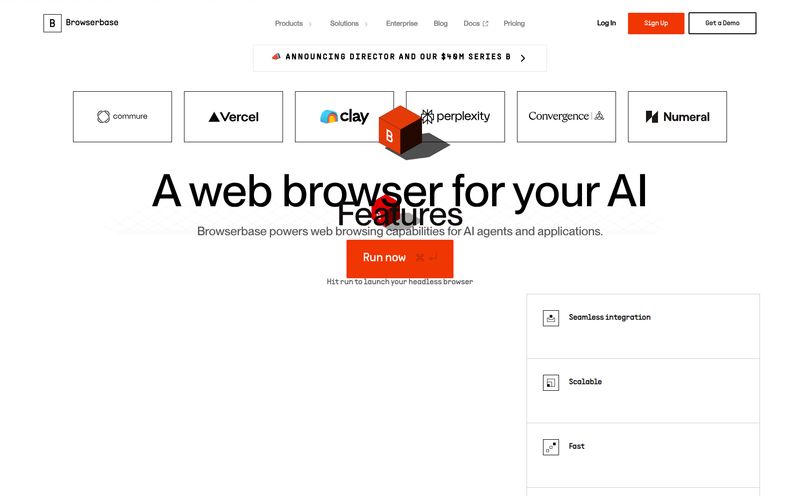How much of your day is spent just… searching? Searching through Slack channels, sifting through CRM notes, trying to piece together a client's history before a big call. It’s a digital scavenger hunt, and the prize is just being able to do your job properly. We’ve built these incredible tech stacks to make us more efficient, but sometimes it feels like we just created a dozen different places for crucial information to go and die.
I’ve been in the SEO and traffic generation game for years, and the one constant is the firehose of information. More data, more channels, more notifications. Ping. Ping. Ping. It’s exhausting. So, when I hear about a new AI tool promising to bring “clarity,” my professional skepticism kicks in hard. We’ve all seen platforms that promise the world but just deliver another dashboard to ignore.
But every so often, something comes along that makes you lean in a little closer. For me, recently, that’s been a platform called theGist. It’s not trying to replace your CRM or your Slack. Instead, it’s trying to be the smart layer that sits on top of them all, making sense of the chaos. And frankly, that’s an idea I can get behind.

Visit theGist
So, What Exactly is theGist?
Imagine all your team’s tools—Slack, your CRM, support tickets, maybe even your calendar—are individual musicians in an orchestra. Each one is playing its own tune. Slack is the frantic violin section, the CRM is the steady percussion, and support tickets are the blaring horns of a problem. They're all making noise, but it isn't music. It's just noise.
theGist positions itself as the conductor. It doesn’t play an instrument itself; it listens to all of them at once and tells you, “Hey, pay attention to the violins and horns right now, they’re building to something important.” It connects to your existing SaaS stack and uses AI to surface the right insights at the right time. Its bread and butter is summarizing an entire chaotic Slack channel or thread in a single click. No more endless scrolling. Hallelujah.
But it's a bit more than just a summary bot. The goal is to give revenue teams—that’s your sales, customer success, and account management folks—a sort of sixth sense about their accounts. It’s about catching the subtle cues, the unspoken risks, and the hidden opportunities that are currently buried under a mountain of digital noise. Its a simple concept, but the execution is what matters.
Meet Your New AI Colleagues: The Revenue Agents
This is where things get interesting and, I’ll admit, pretty cool. Instead of a one-size-fits-all AI, theGist uses what it calls “Revenue Agents.” Think of them as specialized little bots, each tasked with a specific mission. It’s not just one AI; it’s a team of them working for you. Based on their site, it looks like they break down into a few key roles.
The Sentinels: Risk and Relationship Agents
These agents are your watchdogs. The Risk Agent is constantly scanning communications for warning signs. Things like a sudden drop in engagement, mentions of competitors, or negative sentiment creeping into conversations. It’s designed to raise a red flag before a client calls to cancel, not after. The Relationship Agent is similar but focuses more on the human element, tracking the health of your connections with key contacts. It's like having a team member whose only job is to ask, “Are we okay?” with every single one of your clients, all the time.
The Go-Getters: Growth and Engagement Agents
While the sentinels play defense, these agents are on offense. The Growth Agent is looking for buying signals. Did a client mention a new project they’re starting? Did they ask about a feature that’s part of a higher-tier plan? This agent surfaces those moments as potential upsell or cross-sell opportunities. The Engagement Agent, on the other hand, just keeps a pulse on activity, ensuring no account goes dark for too long. It helps you stay proactive instead of reactive, which is a constant battle for any client-facing team.
The Support Crew: Preparation and Smart Alert Agents
I think this might be my favorite part. The Preparation Agent is a lifesaver. It automatically generates pre-call briefs by pulling the latest interactions, open issues, and key details from across your connected apps. Imagine walking into every meeting fully briefed without spending 30 minutes on that digital scavenger hunt I mentioned earlier. Then you have the Smart Alerts Agent, which seems to be the central nervous system for all the other agents, sending you timely, contextual pings about what matters most right now.
Beyond the Buzzwords: How Does This Actually Make You Money?
Okay, cool features are nice. But as someone who lives and breathes CPC and ROI, I have to ask: how does this translate to the bottom line? A tool is only as good as the results it generates.
The value proposition here seems pretty clear. First, stronger retention. Churn is the silent killer of growth. By flagging at-risk accounts earlier and with more accuracy, you stand a much better chance of saving them. Second, smarter revenue growth. You can’t act on an upsell opportunity you don’t see. By surfacing these moments automatically, you’re basically creating a pipeline of expansion revenue from your existing customer base—the cheapest and best kind of revenue to get. Finally, there's team efficiency. Time is money, right? The less time your highly-paid account managers and sales reps spend on administrative busywork (like digging for info), the more time they can spend on high-value activities like talking to customers and closing deals.
The Real Scoop: Practical Pros and Cons
No tool is perfect. Let’s pour a strong coffee and get real about what to expect. From what I can gather, here's a balanced view.
| The Good Stuff (Pros) | The Things to Consider (Cons) |
|---|---|
| Slashes through the noise with real-time insights and alerts. | Requires integration setup. This isn't plug-and-play in 5 minutes; it needs thoughtful connection to your tools. |
| Plays nice with your existing SaaS tools, so no need to rip and replace. | Its effectiveness is directly tied to the quality of data you feed it. Garbage in, garbage out. |
| Genuinely seems to foster better team collaboration and visibility. | There will likely be a learning curve. To get the most out of it, your team will need some training. |
| Directly impacts revenue growth and customer retention. | Another subscription to manage. The cost needs to be justified by the ROI. |
In my experience, the “cons” here are pretty standard for any powerful business software. You have to invest time to get value out of it. If you’re not willing to connect it properly or train your team, it’ll just become another unused icon on your browser bar.
The Million-Dollar Question: What's theGist's Pricing?
And now for everyone’s favorite part: the price tag. I scoured their site, and as is common with B2B SaaS platforms of this nature, pricing isn’t publicly listed. This usually means they operate on a quote-based model tailored to your company's size and needs.
I’d wager it’s a tiered subscription, probably priced per user, per month. There might be different packages based on the number of integrations or which “Revenue Agents” you want to activate. The lack of a pricing page means you'll have to get in touch with their sales team and book a demo to get a real number. While I always prefer transparent pricing, this approach does allow them to build a custom package, which can be better for larger teams with specific needs.
Frequently Asked Questions About theGist
- What tools does theGist integrate with?
- While the specific list requires a demo, it's designed to connect with your core revenue workflow tools. Think major CRMs like Salesforce, communication platforms like Slack, and potentially helpdesk software like Zendesk or Intercom.
- Is my company's data secure with theGist?
- Security is a top concern for any tool that accesses company data. Their website has a "Security & Privacy" section, which is a good sign. Any serious platform in this space will have robust security protocols like SOC 2 compliance. You should definitely ask for their security documentation during the sales process.
- Who is the ideal user for this platform?
- This seems tailor-made for mid-market to enterprise-level B2B companies with dedicated revenue teams (Sales, CS, AMs) that rely heavily on tools like Slack and a CRM to manage complex customer relationships. A small team or a solopreneur might find it to be overkill.
- How long does it take to get set up?
- This will vary. Connecting the APIs to your tools might be quick, but the real “setup” is tuning the agents and training your team. I'd budget a few weeks for a proper implementation and onboarding process to see real value.
- Is it just another Slack bot?
- From my analysis, no. While it has deep Slack integration (like the summarization feature), it’s not just a Slack bot. It’s a broader intelligence platform that uses Slack as a key data source and a place to deliver alerts. The real work happens in the background by connecting dots across multiple systems.
My Final Verdict on theGist
So, is theGist the magic bullet that will solve all your problems? Of course not. No tool is. But is it a genuinely intriguing solution to a very real, very frustrating problem? I think so.
We are past the point of just needing more apps. We need our apps to talk to each other and, more importantly, we need someone—or something—to interpret that conversation for us. theGist's approach of using specialized AI agents to act as a dedicated intelligence layer for revenue teams is smart. It’s focused. It’s not trying to do everything; it's trying to do a few very important things very well.
If your team feels like they are constantly playing catch-up and you know that valuable information is slipping through the cracks, then getting a demo of theGist seems like a no-brainer. It could be the difference between just having data and having true, actionable intelligence.
Reference and Sources
- Direct analysis of theGist's official website content and imagery. For more information, you can visit their site directly or request a demo.
- For general reading on Revenue Intelligence platforms, resources like G2's Revenue Intelligence category can provide market context.



